foot in mouth: October 2009 Archives
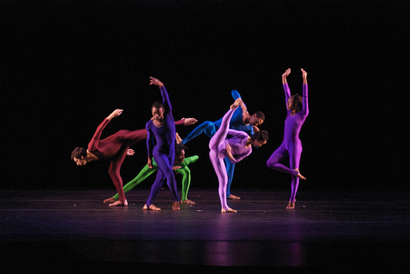
Mudan 175/39 by Garth Fagan. Photo by Paula Summit.
I don't think this year's Joyce season is the best showing of Fagan's work. There's only one premiere--the lovely Mudan--but even that wouldn't be a problem if the rep didn't also fall on the minimalist end of the Fagan scale.
Still, I admire the Rochester choreographer's aim and method enough to not much mind if one year is less revelatory than another. I want to avoid being one of those critics who uses an artist's previous seasons against him (that is, via invidious comparison). It should matter that this is Fagan's 39th year at his post.
Here's the start of my Friday review for the Financial Times:
Since founding his company four decades ago, Garth Fagan has lived and worked upstate, impervious to the fret and ferment surrounding novelty that absorbs our local choreographers. The resulting palette of often refreshingly démodé moods and methods is prominently on display this year at the Joyce (until Sunday), perhaps because of the subdued character of the season's premiere and featured repertory.Shades of calculatedly guileless cheer or gloomy anomie dominate contemporary dance; Fagan - who mounted annual seasons downstate for years before achieving broad acclaim with a 1998 Tony for his Lion King choreography - prefers an easy, friendly cool.
The Jamaican émigré treats his wide array of music - jazz, ska, fusions of western and eastern classicism - as neither mood thermostat nor metronome but like a lover or brother whose drift he knows so well that he can dip in and out in unhurried conversation. Many dances today stop only long enough to implode; Fagan's can be brazenly slow, with the dancers become a garden of stone before they calmly carry on. He does not forgo steps for vectors of energy; he likes his shapes. A "Y" tilted off its axis, a body hinged forward or back at the hips, split leaps: he angles limb to torso in clean geometries. Most of the time, the shapes don't speak except to say "shape". Fagan is a proud formalist.
This year, I found myself wishing he were less proud....
For the whole review, click here.
I asked my friend and Foot colleague Paul Parish whether I could paste some of his review last week of Bill T. Jones's and Joe Goode's latest shows--Jones's is the big Lincoln fete we New Yorkers will be getting some side dishes from later this month at the Joyce--and he said, yes, please.
There's all sorts of observations Paul makes that have me starting up with excitement--the unusual way he defines dance theater, his mix of admiration and skepticism for Jones "work[ing] your nerves," etc. Here, from The Bay Area Reporter:
It's just a coincidence that Bill T. Jones and Joe Goode, two major gay choreographers who deal with gay themes, have opened shows back to back (and at the same time as the national LGBTQ protest for Equal Rights in Washington, DC). Just a coincidence, but it feels portentous, like something's about to give. I have to say, I don't know which way things are going to break.
Not all dances are "about" something. There's a kind of pure-dance theater that is "just about the movement." But there is, at the other end of the spectrum, a kind of dance theater that's about life in the body: movement, physicality, relationship, sexuality, love, hate, anger. It's made of stylized, heightened action, is sometimes closer to acting than to "dancing," and can be gritty, naturalistic, even journalistic. Both Jones and Goode work this end of the spectrum, using gay themes that obviously grow directly out of their lives. Both of them rose to prominence in the AIDS era - i.e., when there was no cure in sight. Dancers then often performed as if there were no tomorrow.
Goode's breakthrough piece, 29 Effeminate Gestures, could have been the anthem of ACT UP. It put gay anger on the map in a new way that made him famous nationally. The pieces he made about his friends dying of AIDS melted your heart and made you love him, and won him New York's Bessie Award, their highest honor for modern dance.
Goode does not have HIV, but Jones does; back in the 1980s, Jones and his partner, Arnie Zane, who had AIDS and was dying, made dances about their relationship which were formally innovative and electrifying theatrical exploitations of personal material. I'm using the word exploitative retrospectively; at the time, it was a fighting word - who were critics to tell dying people that they were exploiting themselves? When Arlene Croce, the great critic at The New Yorker, did rebuke Jones for such self-abuse, she was destroyed in one of the great critical contretemps of that era, from which the dust has not yet settled.
Goode and Jones are both still here, and they've both made spooky shows - reverberating, echo-filled theater-pieces with some thrilling dance, moves that seem quite secondary to the words that careen like cannonballs in a war inside the psyche. Both resemble those dreams from which you can't wake up, where the sounds in your head set up a cacophony of tension, and you can't decide what they mean or what to do.
Goode's Dead Boys is a melodrama he's written for UC's Department of Theater, Dance and Performance Studies (where he's been invited onto the faculty). It centers on a young gay artist, kind of a loner, who lives in a boardinghouse with some friends, but suffers nightmares about gay boys being choked, beaten, drowned; he comes to find out they're real. Most of the action is psychodrama, and it's expanded and made eloquent by the shimmering, sad music of Holcombe Waller, the folk/indie Portland composer who's collaborated with Goode; the piece is not through-composed like an opera, but previews of it put me in mind of an opera like Dialogues of the Carmelites. The show opened the weekend of Oct. 10, and continues this weekend at Zellerbach Playhouse. David K.H. Elliott's visionary lighting creates haunting effects.
The actors (aside from Prof. Lura Dolas, who is tremendous as the landlady) are students, but they are talented. It remains to be seen how well they can maintain an atmosphere which requires so much suspension of disbelief, but the material itself is haunting, and, in the sketches I've seen so far, I recognize much of my own experience as a queer trying to sort out my identity, my hopes and fears, and find ways of connecting to others. I had to leave for DC before the show opened, but it seems very promising, and honest in its conception.
Honest Abe
Jones' ambitious Fondly do we Hope, Fervently do we Pray arrived at the Yerba Buena Center hot from its premiere last month at Chicago's Ravinia Festival, which commissioned a piece about the bicentennial of Abraham Lincoln's birth. It owes a lot to Ken Burns' Civil War documentaries and our familiarity with them. Jones quotes Lincoln like a preacher quoting Scripture, and bends old hymn tunes to his purposes.It's dangerous not to praise Bill T. Jones. (Look what happened to Croce.) He's in a position to flip liberal guilt like a ju-jitsu artist, since he's both gay and African-American, and as a postmodern New Yorker, he's seen how his fellow artists in the visual media pay more attention to crafting their reputations than their pictures. The fascinating thing is that he really does play it close to the edge. He used to parody "I'm Chevy Chase, and you're not" by coming out onstage. He'd posture, strip down to a little white skirt or the altogether, and harangue the audience, "I've got AIDS, and you don't," and he'd get away with it. Or he'd get his mother onstage to sing a gospel song (she's great) and dance to that. He worked your nerves.
He's still doing that. The center of the piece is a poetry slam echoing the Lincoln-Douglas debate. He's on both sides of every question, even suggesting that he's got sympathy with states' rights.
A piece with so much discord requires powerful containing forces to keep it from exploding, and the organizing forces were glorious.....
I didn't do either in my review for the Financial Times tomorrow of the popular European choreographer Sidi Larbi Cherkaoui's Orbo Novo. There were other things, for which I felt distinct dislike, such as the dance's confusion about its stance towards its material (a woman entering nirvana by suffering--if that's even the right way to put it-- a stroke). It's okay for the choreographer to be ambivalent, but the ambivalence needs to be part of the work's structure rather than passed off surreptitiously on the viewers.
So about that movement, Cherkaoui has devised an edgeless, Gumby style mosaic of motion. No limb ever straightens all the way; no phrase ever finishes, it simply subsides. After a while it makes me feel blurry. On the one hand, I've never seen anything quite like it before (though nearly). On the other, I don't really care if I see anything quite like it again.
Is newness so important that it doesn't matter what is new?
Probably.
Speaking of novelty and problems, I'd been listening to Saul Bellow's Augie March on CD and marveling over--everything, really, but I guess what I could land on as blowing my mind was the way he lined up adjectives, each one pushing and pulling against the ones nearby to create something entirely more alive than each would be alone. It infected me and I tried my own version. Couldn't pull it off.
Here's a bit of the Cherkaoui review. (And here's the whole review):
Like many ironists, Belgian choreographer Sidi Larbi Cherkaoui harbours a secret gushy heart, and in Orbo Novo it leaks out.
The fault may lie with the 70-minute work's inspiration, neuroscientist Jill Bolte Taylor's Oprah-endorsed account of chancing upon a world of peace, love and understanding: the right hemisphere of her brain. When a blood vessel burst in the chattering, contentious, obsessive-compulsive left half, "the little voice that says, 'Hey, remember to pick up bananas on the way home'," went mute, she writes, and left her "an energy being" floating in the here and now, "perfect, whole and beautiful".This first stateside commission for Cherkaoui - from Cedar Lake, New York's answer to pointe-free athletico-conceptual European contemporary dance - begins by throwing up defensive barriers to Taylor's woozy utopia.....
For the whole thing: here
I go on to complain about the dancers. I know half the town adores the Cedar Lake crew--as do many professional dancers in illustrious New York companies--so what's wrong with me? There's something about them that seems professional in the bad sense: proficient, versatile, but insufficiently invested in the movement before them. I have no doubt they're invested in dancing, but I'm not convinced they care enough about what they're dancing. It's the liability of an ominivore rep company.
Here, though, some dancers I liked:
Golan Yosef, Jon Bond, Acacia Schachte, Jason Kittelberger. Photo by Julieta Cervantes.
After posting Foot contributor Paul Parish's eloquent and provocative outcry on the YouTube crackdown on user Ketinoa's large video collection, I received some illuminating information on copyright law from Marc Kirshner, of the newly formed Tendu TV.
Here it is, filtered through the law-ignorant mind of moi:
--In order to maintain their right to certain dances, organizations such as the Balanchine Trust have to enforce copyright protection. If they don't complain to YouTube, for example, about the Kirov clips of Balanchine works that Ketinoa put up, they're at risk of what's known as copyright abandonment, which means that when a real risk comes along (such as did with the Martha Graham company under Ron Protas), they've relinquished their legal right to prosecute.
THIS JUST IN, from lawyer Elizabeth Russell, specializing in the arts and issues of copyright:
Regarding copyright enforcement, abandonment is a concept that applies in trademark law; but there is no statutory abandonment provision in copyright law. And there's a reason for that: trademark law serves consumers. If a business chooses not to be diligent in policing its trademarks, it is in the consumers' best interest to have the trademark become unenforceable. Copyright, on the other hand, is a constitutional balance intended to protect the rights of authors (including choreographers) for "limited times," in order to encourage the creation of, essentially, cultural material. After the "limited time" is up, that material passes into the public domain. Copyright law thus protects authors, in order ultimately to benefit the public. So there are more protections in copyright law for authors, than there are in trademark law for business owners. And one of those protections for authors is: it's hard to abandon your copyright by accident.
Well, there goes the Balanchine Trust's big excuse!
--About 95 percent of dance companies have not copyrighted their works. It's not particularly easy to do so, because you have to determine the "standard" form--called "fixation" in copyright law--which requires careful video documentation and possibly also notation. It's easy enough to determine a book's fixed form--the version published--but with dance, questions come up such as, as Kirshner put it, "Is the choreography the steps or the movement between the steps?" This made me laugh: isn't the issue of what counts as a step and what a transition a philosophical question that each choreographer answers differently? And how do you convert such aesthetic values into legal criteria?
--As little as five seconds of video can count as copyright infringement. But "fair use" dictates that you may "quote" video the same way you would a passage from a book: in a discussion that contextualizes. You could, for example, embed several Giselle mad scenes within an online essay on how each of the ballerinas approached this pivotal moment. (For more on Fair Use in dance, particularly for collections staff, see the Dance Heritage Coalition's careful, comprehensive 2009 document, "Statement of Best Practices in Fair Use of Dance-Related Materials: Recommendations for librarians, archivists, curators, and other collections staff." Via Ballet Talk.)
I asked Paul for his thoughts on the addition. Here they are:
It may be time to lobby for a MAJOR change in copyright law. Many issues are changing their look -- like the way Washington DC changes as you drive away from one of those circles, the buildings actually shifting places if you're not operating from a grid. The way things are growing now--some things growing, others shrinking--fair use doesn't have to mean "in a critical review," for example.Paul.
Yes, these legal points in no way answer the larger questions about what and who the copyrighting etc. serves: whether the laws as they stand defeat the very artform and artists they're meant to protect (and I do think what serves the artform ultimately serves the artist.)
Here, again, is Paul's original post.
And here is my followup, about the role of borrowing in artmaking and what Balanchine's position on YouTube and the Trust's tight control might have been.
And check out comments by Marc Kirshner et. al.
So, in writing about this month's ridiculous, my big dilemma was whether to allot it one star or two in the Financial Times galaxy. The dancing might have warranted two, but the story the dancing was telling was so benighted.... I finally went with one. Here's the first few paragraphs of the FT review, which came out today:
Another worldwide tango show has arrived in New York, in the sixth year of its never-ending tour. Tanguera - a Movin' Out-style musical, at City Center until October 18 - is too dumb and unambitious to hate, though one can certainly resent it.
You know where the threadbare story is headed as soon as our greenhorn heroine, Giselle of Paris, struts down the gangplank in bare legs and raincoat. The hulky dockworker she bumps into - bing, they're in love! - will rescue her from the stylish Buenos Aires pimps stealing her away to their bordello, but only after she's had to service the stoop-shouldered, myopic and middle-aged. (The other girls get the young, muscled and bronzed.)Better Banguera, in which Giselle leaves her loyal dockworker for the boas, bustiers and paid sex. It would oppress less. Tanguera depends on a simple opposition: the bad guys, with whom the whores don't want to dance but must, versus the good guys, with whom they want to dance but aren't allowed. In other words, half the numbers represent unwilling intimacy (to put it squeamishly). The performers couldn't actually be doing these perfectly calibrated leg waggles without consent, though, so why not a story that doesn't require so much pretence on their part and suspension of disbelief on ours?
Still, Tanguera would have been less awful if choreographer Mora Godoy had treated the soft-porn plot as a dancemaker's challenge....
For the whole thing, click here.
And now for the sublime, which was doubly pleasurable because I wasn't expecting it. You have only through Friday to see the young Italian choreographer Matteo Levaggi's Primo Toccare at the Joyce. Given the size of the opening night audience (woefully small--about half full), I'll bet you could get $10 tickets.
Vito Pansini (man) and Yi Chun Liu (woman) with anonymous model in the White section of Matteo Levaggi's Primo Toccare. Photo by Massimo Pinca.
The dance, with its eight elegant, soft-spoken dancers, belongs to Balletto Teatro di Torino (Turin Ballet to you and me). The weekend program consists of older and perhaps less delectable works. Don't let the washing-machine sound effects or the chilly, portentous set or the live dead models set your mind against this dance. It has a mind and voice of its own.
Here's the start; Financial Times review out tomorrow. (Did you know that it's not just the Clash that says spe-ci-al-ity?)
It is a rare choreographer who makes you feel you are not waiting for anything to happen, because it already is happening - every moment "a visible action of life", as Merce Cunningham once put it. In Balletto Teatro di Torino's New York debut on Tuesday night before a small but enthusiastic audience, 31-year-old Matteo Levaggi proved to possess that elusive talent.For Primo Toccare (First Touch) - the first of two programmes of his work at the Joyce this week - he hedges his bets, allowing himself and his collaborators to stuff the dance with accessory meanings. Art-fashion team Corpicrudi lays the vanitas on thick with a coffin-shaped vitrine that displays first a skull and lilies, then two motionless models standing while staring blankly out at us. The sound score denatures the heavy breathing of lovemaking so it turns into white noise; on the other hand, it blasts churchy organ at such high decibels, you pray for earplugs.
Yet Levaggi - a pure product of Turin Ballet whom long-time director Loredana Furno designated resident choreographer at the tender age of 23 - is so engaged in the essential choreographic questions of timing and juxtaposition that the Euro-angst pretensions do not stick. Primo Toccare's confidence in dance as an end in itself carries us through on a serene pulse of attention.
Step for step, the movement is nothing special. Batsheva's Ohad Naharin achieves more dramatic effects with a torso's squiggly undulations. Other choreographers have used splay-fingered, wrist-cocked monster hands just as endearingly. The flying karate legs with cantilevered torso are a Forsythe speciality. And Levaggi's fondness for squatting fourth positions reminds me of Cunningham.
But the tone of sublime gentleness.....
To continue Paul Parish's incredibly smart discussion of why we--potential live-dance audiences, actual live-dance audiences, committed dance enthusiasts, dance scholars--all need video libraries like the Ketinoa collection on YouTube, here are two useful sources I dug up:
--Novelist Jonathan Lethem's fantastic 2007 Harper's article, "The Ecstasy of Influence," on how artmaking necessarily involves borrowing, in which he reminds us:
The first Congress to grant copyright gave authors an initial term of fourteen years, which could be renewed for another fourteen if the author still lived. The current term is the life of the author plus seventy years. It's only a slight exaggeration to say that each time Mickey Mouse is about to fall into the public domain, the mouse's copyright term is extended.
Perhaps even more to the point, he explains that the reason a film can "borrow" scenes from real life without being accused of plagiarism is the camera itself is enough to make them new. Why wouldn't that apply as well to dance on film? Balanchine certainly understood the distinction, as he made clear in the revisions to his ballets he created for film.
--For those of you wondering how Balanchine might have responded to a YouTube presence, Arlene Croce's January New Yorker article (in full for subscribers) on how most of the wise nuggets of Balanchine's were actually other people's, which he adapted, goes on to point out that this principle applied to his choreography as well.
He subscribed to the Hegelian view of history as a spiral: everything recurs, but in a different form. For this reason, he saw no harm in appropriating: he stole and was stolen from--that was the way of art.
How ironic that Balanchine's presence in the Ketinoa collection caused its demise.
NEW: For a legal perspective on why it might be necessary for the Balanchine Trust and other organizations of its size and stature to play policeman, here's info I gleaned from a Tendu TV exec.
And, again, for Paul's original letter, go here.
While we're waiting for the New York Times to do some investigating on the Balanchine Trust's role in the shutting down of a 1300-video ballet archive on YouTube (nudge, nudge), here's Foot contributor Paul Parish, from the Bay Area:
Hey Apollinaire --
I don't know how upsetting you find this action, but it's really big if you ask me. I went to that archive all the time and studied there for hours at a shot.
Linda at The Ballet Bag wrote an article Sept 2 which begins:
The YouTube Ketinoa channel contained over 1300 videos of Mariinsky & Bolshoi ballets, including extracts of rehearsals, Vaganova Academy examinations, class syllabus, new and vintage performances. Steering clear of the issue of who owns the copyright, [I'll say this channel] served as a film archive accessible to anyone wishing to further educate themselves or simply to enjoy great ballet extracts, with user comments largely praising its content. Last month it was suspended because it was found to contain a small subset of copyright protected videos featuring ballets by Balanchine. The claim was submitted on behalf of the Balanchine Trust, the body in charge of protecting the legacy of that choreographer. Assuming the channel owner received a notification asking for immediate removal of the offending videos, if he/she complied then the account could be re-activated, provided offending videos were not re-uploaded. But YouTube could also have pre-emptively suspended the account without notice to protect itself from any potential lawsuit, in compliance with the Digital Millennium Copyright Act (US), which seems to have been the case with the Ketinoa channel, based on claims by ongoing campaigns to save it.
I first found out about this on Ballet Talk, but as I was composing my thoughts I found myself thinking I should send them to you for Foot.
My immediate personal reaction is that this is a disaster -- Ketinoa's channel!%$ NO! Unbelievable treasury of dance. It's like having the Library of Alexandria go up in flames.
OK, that's an exaggeration, but still, WHAT a collection!!!! And it was like the town library -- we could all use it.
There's certainly plenty to think about here.
First of all, maybe Ketinoa's channel could go back up if the Balanchine material (as danced by the Kirov) is taken down. The Kirov, Bolshoi, etc., are not restricted by American copyright laws, and the bulk of the material is Vaganova or Messerer instruction, theory, practice, etc., so it could all be calmed down.
But it is academic dance, and it's not just a pun to say there are principles of academic freedom involved. Is Ketinoa's channel protected under principles of academic freedom? Or rather, should it be? The dance world has languished so long without libraries, and the rise of video was just beginning to allow dance to be studied like literature, so you could study it and quote accurately, and the autodidact or amateur outside the academy was becoming almost as well informed as some professors. Though it was happening outside a university setting, the growth of serious dance culture was happening in the West rather like the scientific societies of the 18th century, when professional procedures had not yet been codified but people were making collections and study was becoming possible on an unprecedented scale -- and Ketinoa's channel was at the top of the heap for providing the core commentaries and syllabi.
Intellectual property issues are morphing rapidly. Commercial institutions with a financial interest have armies of lawyers pushing for their views, while the public interest has no virtually trained advocates. So what we see is rather like the rapid growth of pro-slavery theory in the old South, which was negligible in 1820 and full-fledged ideology by 1860: right now, intellectual property thought is being pushed by corporations trying to protect their trade secrets, licenses, and royalties.
Intellectual freedom used to be defended primarily against HUAC, against government encroachment, and against religious intolerance, but now the enemy of free exchange of ideas is capitalist NGOs. There are many ways in which the scholarly pursuits come into conflict with corporate interests -- for example, a cartel of publishers has got a stranglehold on scholarly journals and raised the cost of subscriptions through the roof -- to wit, a -one-year subscription to the Journal of Nuclear Physics costs as much as a BMW. [Ed. note: Yeah, but isn't this partly because so few people read them and Bush reduced the funding on science research etc., so that the journals aren't subsidized anymore?] (Side note: universities are right now having to defend against being turned into research and development institutions, and the causes of Liberal Arts is almost sunk since it doesn't even turn up on the radar of quantifiable value added.) [Ed. note: Yes, for the same reasons, I think, as the rising cost of journals.]
YouTube used to be thought of as an extension of first-amendment freedoms to express yourself -- publish yourself, whatever you want so long as it's decent. So it was mostly thought of as individualist. But there's also always been a social dimension to the internet. It was developed as a multicentered web first of all to assure the defense of the United States against attack so that if the "capita" were taken out there'd be other "heads" still able to think and communicate. And in many ways it's created communities of interest that have informal but in fact very tough bonds among members widely geographically scattered.
The issues for dance seem like a fascinating version of those facing all the arts and the sciences. Engineers are now having to face the kind of stunning disrespect the arts suffered 30 years ago.... Librarians are up against it -- can a cartel really fix the price of an academic journal? If so, the articles contained in it are on their way to being considered trade secrets.... Where does capitalism conflict with the public interest? Are there no limits?
Am I letting my rhetoric run away with me?
Do you think Ketinoa's channel is important? Not just in itself, but in the larger issues concerning the life of the mind?
You're a teacher -- what do YOU think? What do you see happening?
Paul
Hi, Paul,
Very briefly here (because, yeah, I'm a teacher and I have a load of essays to respond to tonight), yes, I think Ketinoa and its ilk are really important and, as a couple of us discussed a few years ago (scroll down to second comment, from Griffin), the Balanchine Trust's approach is outdated.
They are shooting ballet in the foot to not let people have any access to these Balanchine recordings. YouTube is how everyone under 40--and a lot of us over-- tries out new things. I use YouTube all the time in my classroom, and it's incredibly useful for giving my students a taste of something not otherwise available. At the start of the term, we'd read Pauline Kael's short essay on the first time she saw de Sica's Shoeshine; the movie isn't in print in the States, but some angel had uploaded it to YouTube! Did the students love it? No, but they liked it enough to watch it on their own--all the way through. And next time they watch an "old" movie, as they put it, maybe they'll like it a bit more.
I think we're at this bad moment vis-a-vis the internet where companies are taking stringent measures after not knowing how to take any measures at all. An example from the music-sharing world is that grad student, I think he was, in Boston who got fined $168,000 this summer for downloading a tune. The idea was he'd serve as an example to the rest of us freeloaders.
I hope some compromise is reached, in cost and/or availability. But it's not likely unless the compromise serves profits--or whatever else is at stake. If for the Balanchine Trust, the issue is that they don't want people performing the ballets without a license, this is foolish too. It's GOOD when a dance enters the culture: someone looking for the latest dance virus ends up stumbling on Edward Villella and incorporates some "move" of his into their own vocabulary. That's how culture is meant to grow and morph. And god knows they won't call it Balanchine--they don't want to be found out any more than that Boston grad student did--and it won't hurt Balanchine's rep or the ballet audience or the Balanchine ballets. Shakespeare monkeys didn't make Shakespeare any less popular. In fact, the opposite. And they didn't make Shakespeare any less good.
It sounds like the Balanchine Trust really played the heavy if YouTube responded by taking all 1300 videos down. (If anyone knows exactly how this Ketinoa flameout occurred, and what the Balanchine Trust's role in it was, we would love to know. And/or the NY Times dance people should be jumping on this story.)
Thanks for this, Paul.
Everyone, you can write to copyright@youtube.com to complain....
For some thoughts on how intellectual property rights have changed since Thomas Jefferson, what stealing has to do with making art, and what Balanchine might have thought of Youtube, a new post.
And for a legal perspective on why it might be necessary for the Balanchine Trust and other organizations of its size and stature to play policeman, here's info I gleaned from a Tendu TV exec.
But first for your edification: Miss Piggy and Nureyev on YouTube!
~ Apollinaire
I think it's really exciting that American Ballet Theatre chose to do three premieres for their fall season: Bravo! And they even picked choreographers with solid--or better--track records: besides their new and cherished resident choreographer, Alexei Ratmansky, prolific 30something choreographers Benjamin Millepied and Aszure Barton.
I've admired works by Barton and Millepied before, but these premieres featured the choreographers' worst tendencies: teenaged ticishness in Barton, and in Millepied, workmanship so poor (imagine unvarnished wood that splinters at the touch--and the fault was not with ABT's committed dancers) that it's impossible to locate his intent, to find something in the piece to follow out.
I'm very hard on him in the review for the Financial Times below (and here, in full)--maybe because he starts the piece by weaving geometric patterns with the 26-person ensemble--large for the Avery Fisher Hall stage--in which he doesn't seem to hear the very nifty rhythms in David Lang's Reichian, shapeshifting score. Lang's rhythms keep surprising, the new measure starting on the last beat of the previous one, as if the wings of time were being clipped. To ignore it--to square the beat--dizzies any viewer not rhythm-immune.
In any case, Millepied is trying to create a sense of stark linear patterning, then swirly amorphous forms, but the effect in both cases is too much of a muddle.
In its second movement, the ballet moves into a cold, faceless pas de deux between Isabella Boylston and Marcelo Gomes (Gomes reduced to porteur) that probably is supposed to have some relation to the opening section.
I could go on.....
My favorite moment was trickster Daniil Simkin leaping into the arms of a huddle of men. It's usually the women who get carried aloft by a horde, so it was neat seeing an impish intruder do it. I liked Millepied's idea of having a jester among the somber crowds, but as it wasn't clear what had been there before the jest, it didn't really rearrange the dance's chemistry.
Simkin and the boys, in Millepied's Everything Doesn't Happen at Once, (where it pretty much does). All photos by Gene Schiavone for ABT.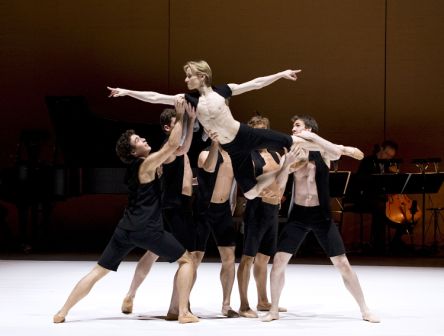
Anyway, here's a chunk of my Financial Times review:
Three exceptional things about American Ballet Theatre's autumn season this year: it is short, over by Sunday; it takes place at the Avery Fisher concert hall, where the acoustics are great and the sightlines terrible; and - to compensate - it consists almost entirely of premieres.
In his second work as ABT's resident choreographer, Alexei Ratmansky knew what to do with the shallow stage: create an intimate piano ballet. That was the speciality of Jerome Robbins, whom the former Bolshoi director resembles in treating the stage as a real place, and people with all their idiosyncrasies as the drama. Robbins used Chopin for his character gems; Ratmansky makes the inspired choice of Scarlatti - less moody than Chopin, more mercurial (and pearly) than the composer's contemporary, Bach.
Seven Sonatas begins by acknowledging the music's Baroque purity. The six dancers, in Holly Hynes's all-white riffs on courtliness, behave. The three men kneel before the three women; the women do not tease, disappear or collapse in despair. Not for now.
But once each couple is alone, with a sonata to itself, it becomes irrepressibly itself. Stella Abrera wreathes Gennadi Saveliev in a fog of terror that will only lift, she fears, if she reaches beyond the circumference of their love. Herman Cornejo and Xiomara Reyes happily subsist on flutter and flirt, buoyancy and braggadocio. David Hallberg - in whom the choreographer has cultivated a nuanced and demonic fervour - is in love with love; Julie Kent feeds his fire by making herself scarce.
Stella Abrera and Gennadi Saveliev, aching and resisting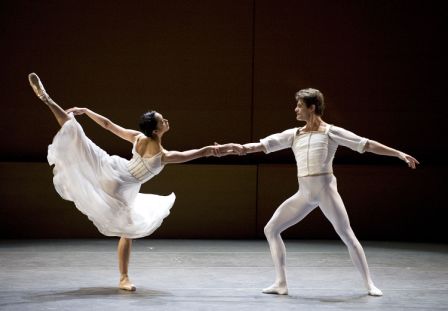
To create these complex characters, Ratmansky tweaks the classical vocabulary. Faced with his lover's imminent dissolution, a kneeling Saveliev grimly lifts an imaginary sun from one side of his body to the other, from sunrise to sunset. His situation has come to feel as impossible as carrying the sun - but also honourable, since this sun takes after fifth position, a planet in the ballet universe.
As a necklace of miniatures, Seven Sonatas can treat us only briefly to the simultaneous long and short view that Ratmansky, alone among choreographers, offers. He has this trick of depicting characters both lost in their own world and partaking witlessly in others'. For the last sonata, the six dancers move - all at once and every which way, in a goofy ecstasy - as their characters have dictated, until a looming threat overwhelms them. The women lie down and the men kneel behind them, bowing their heads as if over a grave.
After Ratmansky, the evening barrels downhill. Choreographer Aszure Barton, whom Baryshnikov has long championed, adores eccentricity but can only imagine it in libidinal terms. Unavoidable urges spout from the dancers' bellies and shoulders, and erupt from their toes. The theme favours men (for some reason) and so, in One of Three, we get them. In suits, to reinforce the idea that they didn't mean to let it all hang out. For double reinforcement, Gillian Murphy plays a mystery lady, with a finger to her lips. But the secret has already been blown.
Eric Tamm and Cory Stearns, with Murphy.
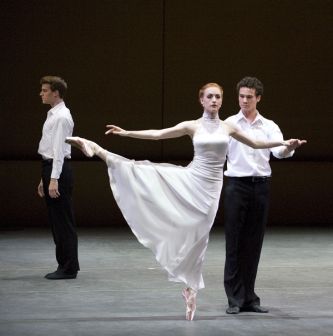
Today's ballet choreographers don't always know what to do with women, but that is the least of Benjamin Millepied's problems.....
On Monday, Paul Parish reports from the free speech and video front.
That would be Fall for Dance, which just finished its five-program, two-week run at City Center. Here's my Financial Times review of all but the final program, and here's a teaser for those not so sure they want to click:
The all-ages audiences for City Center's Fall for Dance festival are a democracy's dream. People are so buzzed from having snagged the $10 tickets that sell out in a day that they're rapturous about everything they see - and keenly attentive. For master puppeteer Basil Twist's glorious take on Fokine's 1911 Petrushka, they burst out laughing whenever the balsawood Ballerina made a finicky adjustment to her refined pose, weightlessness and her vanity perfectly matched. ("Wrong!" shouted a rabid balletomane - proof of Twist's parodic precision.) Everyone understands that this two-week, five-programme dance smorgasbord is a present to us.
But it's also supposed to be a gift to dance - encouraging people to try another show some time (at City Center, with luck). That's the rationale for the buffet approach: with a slice of modern and a side of tap, everyone's going to like something.In my experience, no one likes anything as much as when the menu coheres. So it's an improvement that Fall for Dance comes with a timely theme this year: Diaghilev's Ballets Russes, riffed on and reconstructed, on the centennial of the company's birth.
The reverberations from the fantastical and propulsively dramatic works that Diaghilev commissioned (from 1909 until his death in 1929) from Fokine, Nijinsky, Nijinska, Massine and Balanchine have stretched far into ballet and modern dance. To take one example, dance has long exploited the tension between the mechanical and the natural: a dancer spins like a top, then bows like a prince. The Ballets Russes opened up where the emphasis might fall, so the mechanistic was no longer confined to technique. It might shape style, too - the angle of the arms, a gesture's rhythm. Track just this one effect, and you could fill all 20 spots on the Fall for Dance roster without breaking a sweat....
(Photo by Ryan Galbraith.)
Emio Greco | PC's [purgatorio] POPOPERA is kind of a mess, but if you love movement --watching it created with the breath, thought about unusually--you should head over to the Joyce this week (through Sunday). And you could probably get in for $10. (The Joyce has "updated their pricing structure"--i.e. succumbed to recession specials. On Tuesday, there were a lot of empty seats and gleeful 20somethings, who must have just wandered in.)
It's so rare that European "contemporary dance" choreographers--you know, blessed with those well-funded regional centers--actually do anything interesting with the movement. It's almost always the same liquid thrashing.
Anyway, this is what I said in the Financial Times today:
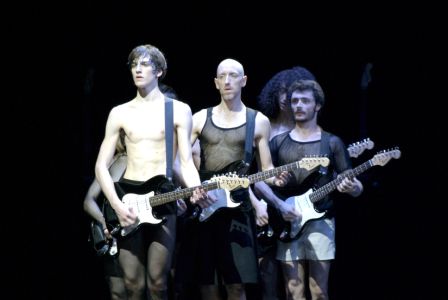 Photo by Igor Mendizibal
Photo by Igor Mendizibal
No, [purgatorio] POPOPERA, despite its title, is not one of those impudent European stagings of a canonical work, high on concept and low on everything else. You know, Nijinsky's lethal Rite of Spring played out in undies on Astroturf, or the Faun in The Afternoon of a Faun pleasuring himself atop an enormous tissue box. Neither idea nor setting defines the purgatory fomented by Amsterdam's Emio Greco and Pieter C. Scholten, collaborators since 1995. Dance does, and eventually five dancers wielding electric guitars. This work - at the Joyce until Sunday after touring Italy and France last year - unfolds organically from the inside out.The movement is eloquent. The arms and hands, especially, tend to complete a flung phrase as if catching fireflies in a jar: energy made visible. The dancers cup their hands like lotus flowers to crown arms thrust overhead. They swing their arms wide to say, "Here I am, for what it's worth". They narrow those arms to dive into space as if it were water.
Purgatorio's tremendous dancers seem to be capturing and releasing air - an apt metaphor for the effort and slipperiness of liberating oneself from tiny sinful thoughts. And by delineating negative space - the space between them - they become a tribe. Every jangly chord crashing down on them from some guitar god in the sky (the erratic score is by Michael Gordon of Bang on a Can) propels these hapless habitués of limboland, by turns goofy, innocent, and mysterious, into another fit of steps.
About two-thirds through the hour-long work, the dancers each gain a limb - a shiny black electric guitar - and....
For the whole review, click here.
Upcoming (next week): Foot contributor Paul Parish on an impending threat to our online dance library, aka YouTube.
AJ Blogs
AJBlogCentral | rssculture
Terry Teachout on the arts in New York City
Andrew Taylor on the business of arts & culture
rock culture approximately
Laura Collins-Hughes on arts, culture and coverage
Richard Kessler on arts education
Douglas McLennan's blog
Dalouge Smith advocates for the Arts
Art from the American Outback
Chloe Veltman on how culture will save the world
For immediate release: the arts are marketable
No genre is the new genre
David Jays on theatre and dance
Paul Levy measures the Angles
Judith H. Dobrzynski on Culture
John Rockwell on the arts
innovations and impediments in not-for-profit arts
Jan Herman - arts, media & culture with 'tude
dance
Apollinaire Scherr talks about dance
Tobi Tobias on dance et al...
jazz
Howard Mandel's freelance Urban Improvisation
Focus on New Orleans. Jazz and Other Sounds
Doug Ramsey on Jazz and other matters...
media
Jeff Weinstein's Cultural Mixology
Martha Bayles on Film...
classical music
Fresh ideas on building arts communities
Greg Sandow performs a book-in-progress
Harvey Sachs on music, and various digressions
Bruce Brubaker on all things Piano
Kyle Gann on music after the fact
Greg Sandow on the future of Classical Music
Norman Lebrecht on Shifting Sound Worlds
Joe Horowitz on music
publishing
Jerome Weeks on Books
Scott McLemee on books, ideas & trash-culture ephemera
theatre
Wendy Rosenfield: covering drama, onstage and off
visual
Public Art, Public Space
Regina Hackett takes her Art To Go
John Perreault's art diary
Lee Rosenbaum's Cultural Commentary
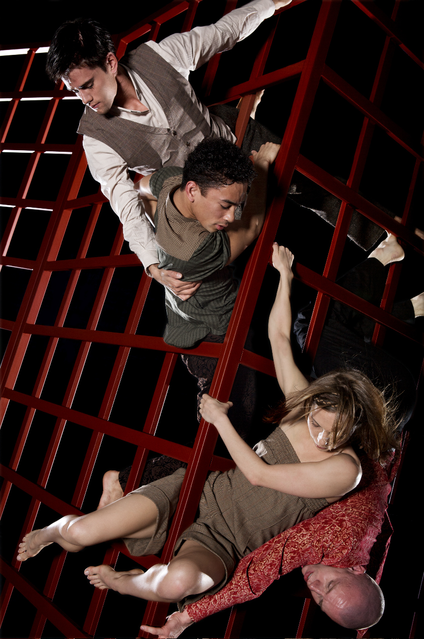
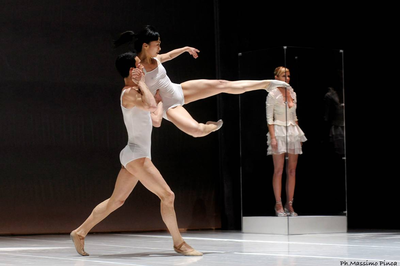

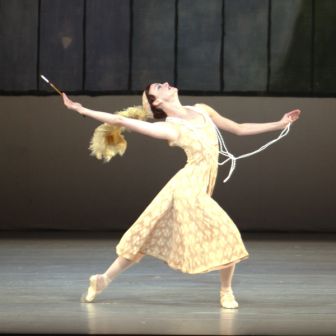

Recent Comments